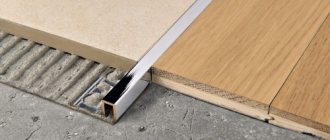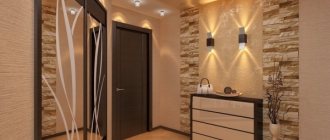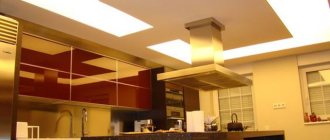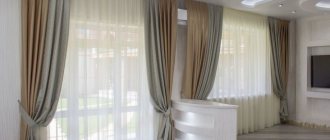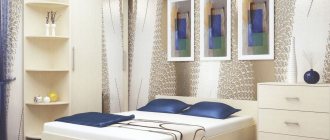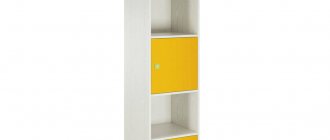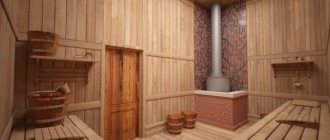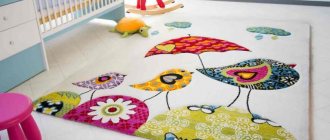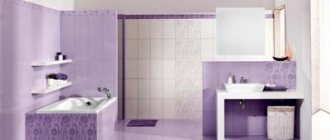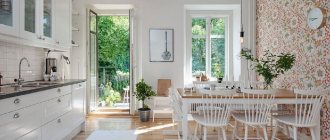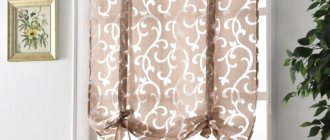Wall decoration with parquet boards: design options in the apartment
There are several design options when decorating walls with parquet boards:
- Across the wall;
- Along;
- In a diagonal direction;
- Over the entire surface of the wall;
- On a separate site;
- Arbitrarily.
Depending on the style of the room, the choice of parquet design may vary, which will merge into a single image with the rest of the room or emphasize its individual parts.
Sheathing on plasterboard walls
In the case where the walls were lined with plasterboard as part of a previous or current renovation, this only plays into the hands and also makes the work of the home craftsman easier. You will need to make a sheathing of wooden slats 20x20 mm, with a distance between the slats of thirty to forty centimeters.
The sheathing under the sheets must be installed level, and therefore it is recommended to use a building level.
The orientation of the parquet and sheathing slats is directed in different directions, that is, they must be perpendicular to each other. If the tiles are placed diagonally, the slats will go in the same direction, but they must be perpendicular to the floorboards.
If only the lower section of the wall is sheathed, then work also begins from below. But if the entire wall is to be sheathed, then the first tile is laid in the upper part. Then the movement is from left to right. In this situation, the same rules for laying parquet as on the floor apply - there is a need to provide a technological gap between the walls and the edge of the parquet.
The dies are attached using parquet glue or by driving staples into the corresponding locking joints. If glue is used, it is applied not only to the wall, but also to the back of the dies, using zigzag movements.
As the final stage, the installation of skirting boards and corners is carried out. Thanks to them, technical gaps left in advance are closed, as well as joints with the floor and ceiling.
How to mount on concrete or brick walls
The process of installing concrete or brick walls will be no different from a wall made of plasterboard or chipboard. The main requirement is that the wall must be smooth and free from flaws, defects, and damage.
If it is necessary to mount heavy objects on the wall, a concrete wall partially wins among other options. The most powerful fasteners can be driven into a concrete wall that can withstand heavy loads. For other situations, you will need an individual approach when choosing the type of fasteners and the method of their location.
Flaws
There are an order of magnitude fewer negative factors, but the disadvantages should be taken into account before decorating the premises:
- Sensitive to increased moisture and temperature changes. Significant temperature fluctuations, constant contact with water, high air humidity are the main “enemies” of laminate flooring. The product may quickly deteriorate. One intense contact with water will cause swelling. Unfortunately, the joints caused by water ingress appear noticeably without regaining their previous structure.
- Surface preparation. When you plan to glue the laminate directly onto a plane, it must first be leveled. Surface preparation requires additional time, money and effort.
- Not suitable for finishing all walls in the room. In a huge room with a high ceiling, you can decorate one of the walls or the ceiling with the effect of wooden beams. Complex surface cladding is not an option - it’s too messy. You will still have to level, paint or wallpaper the remaining walls.
Examples in the kitchen and living room
With the right selection of materials for wall decoration, you can achieve significant design success. The result also depends on the choice of textiles, furniture, colors and some other factors that are taken into account when decorating a kitchen or living room.
In these rooms, variations in the laying of parquet are of considerable importance. Depending on the expected effect, you can use one of the main options:
- The horizontal arrangement of the panels makes it possible to visually expand the room, which can be important for a kitchen, which is usually small.
- Vertical installation visually increases the height of the ceilings. This trick is best applied to the living room to achieve incredible design solutions.
- Diagonal cladding is a universal option that makes it possible to blur the volume and boundaries of the room.
Wall parquet in the interior
The idea of decorating walls with parquet appeared relatively recently. However, it is becoming more and more popular. Many people try to introduce something new into the interior in this way. Some consider this finishing option much lighter than others. And some choose it as an alternative option for finishing walls with wood, considering wall parquet to be the same environmentally friendly material, but more affordable.
Care
When the coating receives minor damage during installation or operation, they can be repaired using putty or special wax.
Parquet panels are cared for using specialized care products. Follow the correct humidity and temperature ranges as specified by the manufacturer.
Using parquet as a wall covering is an unusual, but original and practical solution. This is an easy-to-install and maintain material that is suitable for a wide range of users.
Flooring requirements
There are a number of requirements for the material that is laid in the bedroom. In order for the flooring to last a long time and fit harmoniously into the interior, it must be:
- Aesthetic. Ridiculous colors can ruin anyone's mood. To prevent this from happening, choose a beautiful material.
- With good soundproofing properties, if installed in a multi-storey building. A well-chosen coating will reduce noise generated in the morning.
- Eco-friendly. The coating should not contain any harmful substances that could harm human health.
- Comfortable.
- Antistatic. Thanks to this property, the cleaning process will be easier.
- Warm.
- Wear-resistant.
Aesthetics is one of the important qualities
Attention! The floor in the bedroom should not be slippery.
Black flooring is a popular solution.
There are no special requirements for color design. More often, preference is given to dark boards that match wallpaper of any color. Especially if the wallpaper is in beige tones. They look elegant and sophisticated, adding peace and comfort. To relieve boredom, it is better to lay light boards. They will add weightlessness and create a feeling of celebration. The main thing is to choose the right design.
White boards expand the space
Useful video
Recently, when it comes to renovating an apartment or house, people are increasingly turning to a style of room decoration such as retro or antique finishing.
This style includes a method such as antique plaster or, as it is also called, antique wall painting.
If you want the reflections of ancient times to sparkle in your home, so that the room is made in the spirit of the good old classics, then this finishing option is the most suitable for you. It will help give the room that same effect of antiquity and classic design.
The word “plaster” itself is usually associated with a certain building mass of lime mortar to which sand has been added. It is used for surface leveling and rough finishing. However, this understanding reveals only one side of this concept. Please note that if you add dye and some auxiliary substances to this building mass, you can get an interesting material for creating unique images, in particular antique walls.
Antique decorative plaster became so called due to the resulting appearance, slightly rough and shabby. This is achieved thanks to the latex included in its composition and a special technique for applying the solution to the walls. The result is a light tint effect in areas of greatest friction.
Antique mixtures are durable and easy to maintain.
The positive aspects of plaster with an antique effect include:
- high strength;
- Possibility of use for interior and exterior work;
- Possibility of use in rooms with high air humidity;
- environmental friendliness of the material;
- fire resistance;
- ease of care.
Application technology
As when working with conventional plaster, before finishing walls in an antique style, it is necessary to perform preliminary surface preparation. It is imperative to level the walls, remove all defects, dents, crevices and cracks.
After this, use a construction vacuum cleaner to remove dirt and dust. It is recommended to use a special vacuum cleaner, since construction dust can cause damage to the household appliance due to its entry into the motor through the filter.
Be sure to prime the walls
Now the dry and clean wall must be primed to improve the adhesion properties of the material to the surface. Typically the primer is applied using a long-nap roller or a wide brush. It is convenient to use a spray bottle to spray liquid for this purpose.
After applying the primer, you must wait until the wall is completely dry before you can begin applying the plaster. As a tool, you can use a brush or a long-haired roller.
The plaster is applied in a circular motion, while in some places you need to apply more pressure so that the effect of antique wear appears. If necessary, you can repeat the layer using a slightly different shade from the first. After this, be sure to let the surface dry. Drying usually takes 8-12 hours.
At the final stage, the wall must be rubbed with a hard sponge or fine sandpaper using a special grater. To give the surface a smooth look and shine, you can cover the walls with shiny wax.
The crackle effect is achieved by applying several layers of paint and varnish
Plastering antique walls is the most common way to decorate walls, but it is not the only one. There are cases when craftsmen and designers line the walls with wooden paneling. How to achieve the effect of an antique interior here?
Antique processing of wooden walls allows you to create an internal classic atmosphere, with which you can plunge into the times of our grandparents and great-grandfathers.
Carrying out the work of aging a wooden element is not as difficult as it might seem at first glance.
To give wood an antique effect, you will need the following tools and materials:
- axe;
- metal brush;
- hair brush;
- brush;
- sandpaper;
- drill;
- stain, acrylic paint, wax and clear varnish.
With these tools you can achieve the desired result very quickly and you don’t have to wait for the wood to age naturally. The aging effect is achieved by simulating abrasions, cracks and artificial depressions.
Wood aging technology
With the help of an ax, small potholes are made in the wood.
With the help of an ax, potholes of different sizes should be made on the surface of the lining in any order along the entire wall. In some places we cut off the corners, not paying attention to the accuracy of the work.
After this, the finished areas must be thoroughly sanded using a wire brush. Since the volume of the walls is considerable, a lot of effort is required, you can resort to using a drill with special attachments. Watch a master class on aging wood in this video:
An example of an aged wooden board
During grinding, it is necessary to smooth out all sharp nicks obtained with an ax until the effect of natural damage to the wood occurs. Movements must be performed along the wood fibers. Next, using sandpaper, we remove all protruding chips, while small depressions may form, which will also give our walls the effect of natural aging.
Cover the wood with a dark stain
At the next stage of working with antique wood, you should give the light surface a resemblance to a board that has darkened over time. To do this, we treat the lining using a special stain or dark acrylic paint. After waiting for it to dry completely, sand the surface again with medium-hard sandpaper. You don't have to put in any special effort.
At the final stage, the walls should be waxed or coated with clear varnish and the surface should be allowed to dry.
Antique wall decoration can be done in different ways. We looked at such a common option as antique plaster, and a less common option - antique wooden wall finishing. For an example of antique wall decoration, see this video:
Whatever method you choose, retro style will help transform your home and give it an incredible classic design. The work of giving the walls an antique look is not so difficult; even a non-professional can handle it. All that remains is to add elements of classic-style furniture, and the result will pleasantly surprise you.
Today, various materials are used to decorate a room, and boards for decorating walls in an apartment are recognized as the most popular material.
This is due to the environmental friendliness of the material, its practicality and durability. Later in the article we will tell you which decorative boards for wall decoration can be used to create the interior of an apartment or house, and also provide some simple recommendations for attaching the material.
Selecting the color of the dies
Perhaps the most important criterion for choosing parquet, be it a modular or piece version, is, of course, its color.
Bleached coating
For small and medium-sized rooms, it is best to choose light parquet. The design of the apartment will greatly benefit from this. The fact is that such shades allow you to make the room visually somewhat more spacious. In addition, light shades should be used if you want to make the interior light, modern and versatile.
The light coating makes the interior light and versatile
Note: The only exceptions may be bleached oak and some varieties of exotic woods with light wood.
Light and white parquet (not only bleached oak, but also maple, bleached beech, ash, hornbeam, birch, larch, alder, etc.) firstly, visually expands the boundaries of the room, and secondly, it brings a touch of exclusivity to the interior . This type of coating can have different shades. For well-lit, sunny rooms, professional designers advise choosing light gray parquet in a cool shade. For rooms located on the north side, a warm, slightly beige shade is more suitable.
In rooms with windows facing north, it is worth laying a light covering of a warm shade
This same option, as well as a sand-colored coating, looks better in expensive, rich classic interiors. Cool shades and “worn” look are more suitable for rooms decorated in a vintage style. To decorate the floors of modern interiors, a slightly “blue” version is usually used.
In a well-lit room, it would be best to use a gray, slightly “purple” or “blue” option
Important: White oak parquet will look beautiful in an apartment only in combination with light-colored furniture. Sometimes in such interiors the method of contrasts is used. That is, some elements have, on the contrary, a very dark color.
If you want to finish the floors with bleached oak parquet, special attention should be paid to lighting. Do not use lamps that produce too warm yellow light. In such lighting, the white surface of the floor will most likely appear unpleasantly yellowish. This does not apply only to bleached oak of a grayish tint.
When using a light yellowish tint indoors, the lighting must be selected correctly
Advice: Do not cover parquet with light varnish. This option will most likely look like linoleum or laminate. It is better to treat the surface with wax. Matte light parquet looks much richer than glossy.
Parquet in dark shades
The dark color of parquet is an option that is well suited only for large areas. For example, ebony parquet, highly polished rosewood, dark merbau, stained oak, etc. can also become a real decoration of any interior. Wenge parquet looks very beautiful and presentable in solid rooms. The texture of this wood has a rich red-brown hue with active gold inclusions.
Photo of parquet in the interior. Wenge is one of the most prestigious types
When using dark floor finishes in room design, the method of contrasts is usually used. To prevent the room from looking too gloomy, you can, for example, lay a light carpet on the floor or place light-colored furniture in the apartment. Very often, colors such as cream, wheat, sand, white and soft vanilla are combined with dark parquet. The texture of dark parquet is often emphasized by varnishing.
A light-colored carpet will look best on a dark surface.
Tip: Do not use black parquet to decorate your living space. Otherwise, the interior will look too gloomy. Chocolate or dark brown finishes look much better in apartments.
Other parquet colors
Both dark and light floor finishes, as well as beautiful parquet flooring in other shades, look very impressive in residential areas.
For example, a rich pinkish version of this floor finish (cherry, pear) can look quite aesthetically pleasing. It will fit very well into a modern design room.
A warm, cozy atmosphere can be achieved by using yellowish and red parquet (olive, boxwood, teak). The same effect, but with a touch of solidity, is created by brown parquet: walnut, sucupira, lapacho. The red version of the floor finish - mahogany, padauk, balsa wood - looks very presentable and quite original in the interior of a living space. Gray parquet in the interior is used if you need to give the apartment a modern, stylish look.
Colored mahogany parquet is one of the most beautiful types of floor finishes
An apartment can be decorated with parquet of absolutely any shade. Even not too expensive options can make the room cozy and at the same time presentable. The main thing is to correctly combine this type of flooring with furniture and other furnishings, and also take into account the size of the room.
The best way to give your home comfort and an atmosphere of wealth and luxury is parquet flooring in the interior. If you decide to lay natural wood parquet, then you will like our article with many photos and ideas for inspiration.
Advantages and disadvantages of finishing boards
Boards for interior wall decoration made from natural material (or based on it) have a number of positive qualities, for example:
- Such interior decorative material for the home as wood can be used in different climatic conditions.
- This opens up the opportunity to create any structural element with your own hands.
- Wooden beams are a natural and environmentally friendly material.
- This type of wall covering does not cause any difficulties during operation.
- This finishing material has a long service life.
- In case of failure of a separate fragment, a partial replacement can be performed.
- Laying technology allows you to additionally insulate or insulate the walls of the building.
- The ability to create a different style, age the canvas or choose the desired texture and shade.
- Affordable price.
Despite many advantages, facing surfaces with unedged or edged boards also has some disadvantages, namely:
- Due to an increase in the level of humidity in the room or from exposure to moisture, lumber loses its physical qualities.
- Boards without additional treatment with protective agents support combustion.
- This building material has various defects inherent in wood (resin pockets, knots, cracks, etc.).
- At some intervals, the boards require painting or other maintenance.
- Without treatment with antiseptic solutions, fungi and mold can develop on wood.
Parquet color – choose, don’t make a mistake
Neutral, calm tones with a red or brown tint are classic flooring finishes: calm, familiar, suitable for any interior style, but without zest or originality, standard.
In modern floor design, contrasting light and dark colors dominate. This trend has been observed at all times, and today this design approach is more relevant than ever; interesting and extraordinary solutions are in demand that can transform the space, make it brighter and more expressive. This goal can be achieved thanks to dark and light shades of parquet; it becomes possible to play with the geometry of the room, and such a floor can serve as an excellent background for highlighting other interior elements: furniture, ceiling decor, arches, etc.
Artistic parquet in the interior is always luxurious and elegant; in the photo there is a contrasting ornament that helps straighten the proportions of the room
Light parquet in the interior
It is no secret that light parquet: the very popular bleached oak or maple, as well as birch, hornbeam, beech of some varieties, ash with iridescent white-yellow sapwood will make the room lighter, add airiness and visually expand its boundaries.
For small areas, you should choose a coating of light shades with a subtle texture pattern. If the room is narrow, then it is better to lay even white parquet in a shuttle pattern, perpendicular to a narrow wall or in a herringbone pattern, this changes the proportions, resulting in an optical illusion that the room is wider.
Light parquet goes well with both bright and pastel colors; for a balanced interior, the main thing is to balance the palette
Tip: It is better to cover large areas of the floor with larger tiles, and you can break up the space so that it does not look like a faceless homogeneous mass using dark inserts: highlight zones, the center, or lay a contrasting strip along the perimeter at some distance from the walls.
Light or white parquet is ideal for creating an airy rococo style, ethno trends, and minimalism. An abandoned white oak parquet board will add a touch of lightness and sophistication to the country and Provence style. Black birch will help in creating such modern styles as contemporary and shabby chic; a light palette of boards with thin dark veins and wormholes will look not just luxurious, but emphatically elegant.
For rooms with a lack of light, choose warm shades, such as light golden oak parquet
In sunny rooms, where there is always a lot of light, you can safely lay parquet in cool light shades; for northern and shaded spaces it is better to use warm colors. Creamy, creamy, pinkish, beige parquet will enhance the effect of visual perception; rooms with such a floor always seem larger, taller, more spacious.
Bleached oak in a cold palette can be balanced with bright and warm textile colors
But when laying light-colored flooring, you should know that it will be a reflection of all other interior items. Therefore, it is necessary to choose the color of the walls and ceiling very carefully. For example, white oak parquet in cold shades in combination with yellow or brown walls will become yellow, disharmony will appear in the interior, in this case it is better to use gray, blue or silver shades. But the furniture can be of any color; a light floor is the ideal backdrop for decor and details.
Light parquet goes well with furniture of different shades
Dark floor
Dark parquet is universal, aristocratic, noble, it has been and remains relevant for creating a wide variety of styles. This includes classicism, oriental and Japanese styles, hi-tech, boroque, loft, etc. Although dark floors visually narrow and clearly limit the space, the situation can be corrected with skirting boards of the same color. But the room becomes intimate, cozy, authentic - this is a special world for people who prefer rigor and comfort “in one bottle.”
Black parquet made of tinted oak looks brutal, but at the same time goes well with white furniture with a gold or silver patina; deep dark brown wenge is ideal for cream walls and milky oak furniture. The polysandra floor is somewhat variegated, but you can match it with finishing and interior elements of any shade, from golden honey to dark chocolate brown.
Dark brown wenge parquet is best combined with matching skirting boards and trim; this technique allows you to unify the interior
Dark parquet is an excellent canvas for bright or contrasting decor. To achieve the desired effect, colorful textiles and strict or, conversely, fancifully ornate forms of decor and furniture are appropriate in the design. As for the color palette, any colors can be combined with this floor, but all shades of white, red, purple, and gold look most advantageous.
The dark polysander floor goes well with restrained monochrome walls; furniture of any color matches it
Of course, dark parquet with a glossy finish looks very impressive, deep, stylish, it reflects furnishings and enlarges the space, but all the dust particles and tiny scratches are visible on it. A matte dark floor is a special chic, elegance, respectability, moreover, it is more practical than gloss, it hides scuffs and minor imperfections.
A dark floor combined with white furniture is a win-win technique for creating a strict and elegant interior.
To summarize, I would like to note that black-brown, light and white shades of parquet have many faces. To emphasize all the advantages, complement, smooth, balance and not overwhelm the beauty of the flooring, you should carefully select colors for interior decoration.
The best way to give your home comfort and an atmosphere of wealth and luxury is parquet flooring in the interior. If you decide to lay natural wood parquet, then you will like our article with many photos and ideas for inspiration.
Types of materials
Today, the most popular materials made from wood or based on it are:
- Lining.
- Boards imitated as timber.
- Block house.
- Siding.
- Not an edged board.
Let's look at each of the materials in more detail.
- Lining. As a rule, solid wood is used for production, so the material has a high level of strength and does not cause difficulties during installation. A distinctive feature is that such finishing can be replaced in case of damage, as well as painted, varnished, etc. Since the lining can be presented in different variations, including physical characteristics, it is equally well suited for interior decoration premises, as well as external work (finishing a bathhouse or sauna, terrace, kitchen, and even a living room or bedroom), this can be seen just by looking at the photo.
- Imitation of timber. This is a material that, when assembled, is similar to solid timber. It is this distinctive feature that allows you to give the room solidity. Such a massive and durable material has a high level of strength, is not afraid of mechanical stress, and is also able to withstand environmental factors, but only after specialized processing.
Advice! As you can see, this finishing option is especially good for the living room, and is especially often used in country houses. Installation of the blade is very simple, thanks to the presence of “locks”: the tenon fits into the groove, which significantly speeds up and facilitates the work. This allows you to use the material not only as floor or wall decor, but also to fix it on the ceiling without much difficulty. Ceiling beams will help harmoniously complement the picture and give the room a special atmosphere.
- Block house. This material allows you to imitate a log house made from a cylindrical log. It is used inside and outside buildings due to the presence of canvases of different thicknesses and widths. As a rule, coniferous wood is used to make such boards, which gives not only realism, but also a natural appearance. Larch, cedar or aspen can also be used.
- Planken. This is a small decorative board that is used to decorate small areas inside and outside the house. The material has different textures and comes in a wide range of colors, and easily tolerates moisture. The material is laid end-to-end, but with a small gap, because the material can expand from exposure to moisture.
- Siding. Siding is a decorative material, for the manufacture of which both synthetic and natural materials can be used. Finishing with such material allows you not only to imitate a wooden surface, but also to choose the optimal color and texture. Siding panels are very durable, are not afraid of the sun and moisture, which is why they are often used for exterior decoration. The panels are installed on the sheathing using brackets. Also, when purchasing material, the kit includes instructions and elements that allow you to hide seams and cuts.
- Not an edged board. The material is a board that has a raw edge. This finishing material allows you to create an original room design, especially if you correctly complement it with decorative elements.
How to age wood (video)
Increasingly, walls are decorated with unedged boards without first clearing the wood of bark, which allows you to create the effect of antiquity (a detailed video lesson on how to age boards can be seen below):
Finishing a wall in a bedroom with unedged boards, as in any other residential or non-residential premises, requires pre-treatment of the wood with protective agents that will protect it from moisture and sunlight. I would also like to note that decorating walls with parquet boards, as well as decorating walls with planed boards in a herringbone pattern, are no less popular.
Bottom line
Parquet is a beautiful and noble covering. It is unique in its variety of colors, textures, and performance qualities. Natural wood flooring is valued for its environmental friendliness and ability to add warmth and comfort to a home. So when choosing flooring, think about how it will form the basis of the design of the entire room.
Choosing flooring is always a difficult task. Indeed, in addition to its beautiful appearance, the material must have a number of other properties. For example, to be durable, pleasant to the touch, environmentally friendly and not cause allergies. One of the floor coverings that meets these parameters is parquet. Today we decided to figure out what it is like and how to choose it correctly.
Approximate cost of material
The table below shows the approximate cost of wood from which planed finishing material can be produced.
| Hardwood: | Cost per m2: | Coniferous wood: | Cost per m2: |
| Linden: | From 700 rub. | Larch | From 750 rub. |
| Alder: | From 900 rub. | Cedar | From 550 rub. |
| Oak: | From 3000 rub. | Pine or spruce | From 350 rub. |
| Ash: | From 1500 rub. | ||
| Aspen: | From 1200 rub. |
Since decorating the walls in the kitchen with boards has some differences from installing boards in the bathroom or bedroom, below we will try to highlight the most relevant tips and tricks that we hope will make your work easier.
- The boards can be fixed to a frame partition or glued directly to the walls, like wallpaper, with liquid nails (the wall must be perfectly flat).
- Try not to use an old design solution by choosing one color of wood, even if the species is expensive. Today it is very fashionable and popular to combine different colors and textures, brush boards and even give the walls additional volume by fixing the canvas with an overlap or a herringbone pattern. Thus, finishing the walls with boards in the Provence style looks great.
- The combination of horizontal, vertical and diagonal fixation of boards looks no less original. You can also insert parquet or brushed material or laminate into this combination, creating a herringbone pattern.
- To finish paintwork materials, try not to use synthetic materials, or better yet, do not use them at all.
- If you still decide to use a plain material, decorative elements, additional lighting, and fresh flowers will help to dilute it.
- Since old pallets (pallets) have recently been very often used for finishing in order to save money, it is not recommended to use them in children's rooms. To arrange children's rooms, instead of Euro pallets, it is best to take parquet or other hollow, smooth material that your baby cannot get hurt on.
There is an opinion that the ever-expanding range of finishing materials should gradually displace and eliminate outdated options, but in reality this is not what happens. Traditional solutions are modified under the influence of modern requirements and appear before customers in a completely different light. The most significant example is wood. Well, it would seem that the material is familiar, but over time it not only did not lose, but also strengthened its position.
Today, interior decoration using wood is considered an extremely stylish design option, since wood is not only an aesthetic, but also an environmentally friendly material. Some people mistakenly believe that the only available option is clapboard wall decoration. In fact, there are a large number of alternative paths, which will be discussed below.
Today, the construction market offers a large number of different types of boards: facade, deck, . The last option is the most popular. The demand is due to several reasons.
Material advantages
- It is quite simple to manufacture, since a variety of different types of wood are used for production: from ash, maple, beech, larch to cherry, cherry and pear.
- A wide range of shades allows you to choose the right option for each interior. You can purchase wood in a light shade, or you can find material in a deep dark color.
- Each of the mentioned types of wood belongs to high-quality species and has excellent performance characteristics.
- Parquet boards as a finishing material for walls look good in the interior.
- The affordability of parquet boards allows you to decorate a large room without significant financial costs.
- Additionally, you can “decorate” wood using special stains and wax impregnations. They will not only extend the service life of the material, but also change the appearance for the better.
Prices for different types of parquet boards
Parquet board
Proper covering of the surface with solid wood boards allows you to get a spectacular interior that will be the envy of all your friends. The use of special impregnations based on wax and oils gives the boards a velvet-like appearance. In addition, these products allow you to create a film on the surface of the boards that repels water, which prevents the development of fungus and mold.
Some apartment owners strive to make their homes original and even extravagant in some ways. So if you are tired of boring solutions, then pay attention to the block house, that is, a board whose cross-section imitates the rounded log known to everyone from village landscapes. With the help of this material you can achieve a real “rural” interior in your home.
To make the design look even more impressive, it is recommended to resort to a method such as artificial “aging” of the wood. For this, the method most often used is “brushing”, that is, processing the material with a wire brush. During the processing of wood, fibers are removed from it, which creates an interesting relief. After this, the material is painted and, without allowing the paint to dry, it is removed.
Tools:
- a simple pencil;
- ruler;
- silicone;
- screwdriver;
- screws;
- glue;
- block for tamping laminate;
- jigsaw;
- hammer;
- moldings;
- thresholds.
Laminate with glue
This method seems to be the simplest and does not require additional skills. To make your task easier, it is recommended to assemble the shields from purchased panels in advance. You should thickly coat the “sides” of the panels with glue and glue the elements together so that you get full-fledged shields. These are the ones we have to fix on the surface of the wall. It is important that it is prepared in advance. It will not be superfluous to carry out markings.
The only thing to remember for a successful result: work should start from the lower left corner. In this case, it is recommended to remove the platbands, which are then installed in the old place.
Laminate on sheathing
Stage 1. We take the necessary measurements, calculate the amount of laminate, as well as the number of moldings and other parts that will be needed for fastening.
Stage 2. Using a ruler and pencil, apply markings to the surface of the wall.
Stage 3. Remove platbands from doors and windows.
Stage 4. We install the sheathing, that is, the frame. This is done quite simply - take wooden blocks and fasten them perpendicular to the floor, but parallel to each other at a distance of 40 cm.
Stage 5. We begin to install the material, as already indicated above, from the lower corner of the left side of the room.
Stage 6. We cut the wood in the corners using a hacksaw or an electric jigsaw. Stage 7. We arrange the planks in a checkerboard pattern.
Stage 8. Treat the joints with silicone.
Stage 9. Latch the locks.
The technology of laying it on the wall is really very simple and will not cause any difficulties.
Prices for different types of laminate
Wood wallpaper is an alternative to real wood finishes. A paper base is used as a base, and a special wood veneer is applied to it. The material is sold in rolls.
The cost depends on many factors, but the main criterion is the price of raw materials.
The process of applying wooden wallpaper to the wall surface is not much different from the technology of applying conventional wallpaper. The only difference is the result, as we end up with a wall that looks like it was made of wood.
One of the most unusual and popular interior design options today is saw-cut finishing. A transverse section of a trunk of small thickness is used as the main decorative element. This finishing method is so popular that by now manufacturers have already begun to produce wallpaper and tiles that imitate this pattern. Decorating the log walls in a room is very simple.
First of all, you need to decide how much area you want to occupy with cross sections. Experts do not recommend overdoing it, since an unusual type of decoration on a large scale can only spoil the interior. The best option is one wall, preferably the one located at the head of the bed.
It is necessary to paint it in a calm color, and then apply logs using special high-quality glue. They can be attached close to each other or you can come up with an interesting fragmentary pattern. It all depends on the imagination of the performer.
The most popular type of wall surface finishing using panels is considered to be a herringbone pattern. To implement it, you will need tools such as a protractor, a hacksaw, adhesive tape (double-sided), casing and a pencil.
The finishing process consists of several key stages:
- calculation;
- marking;
- cutting planks;
- fastening.
Let's look at each of them in more detail.
Step 1. Draw up a diagram on a piece of paper of what the finished wall should look like. It is very important to pay attention to the accuracy of measurements. This is an extremely important stage, so you should not approach it carelessly.
Step 2. Using a simple pencil, draw a straight vertical line clearly in the middle of the wall. It will serve as a boundary for the correct laying of the panels.
Step 3. Prepare the panels. This means we take them and cut them at a 90 degree angle so that one edge is slanted. One half of the boards should be cut from the right corner, the other from the left.
Step 4. Take double-sided adhesive tape and attach it to the panels. It is important that each strip has three longitudinal strips of tape.
Step 5. First of all, we attach the middle elements. For this you will need an assistant. We apply the planks at oblique angles, focusing on the drawn line. It is important to ensure that there are no gaps between them.
Step 6. Fix the panels on the wall. To do this, remove the protective film from the elements and press the planks tightly to the surface.
Step 7
This option is most often used for bedrooms, but you can try it in the kitchen as an experiment. Don't be afraid to trust your taste and realize your fantasies. In addition, wood is a material that makes it easy to realize creative ideas.
Prices for popular finishing wall panels
Wall panels
Video - DIY tree on the wall
Instructions for installing the board on the wall
Is it possible to decorate walls with parquet boards yourself, without experience and special skills? This is possible, but only if you approach the process with care and responsibility. Before starting cladding, you need to check the availability of the tools necessary for the work. In the process you will need:
- square;
- folding meter;
- hammer;
- pencil;
- plumb line;
- wedges;
- sharpened knife;
- glue;
- finishing bar and crutch;
- jigsaw;
- drill (cutting attachment - for making holes for pipes with a diameter larger than the diameter of the pipes).
For certain moments, unexpected tools may be needed, so think through everything in advance
The preparation of the base has already been noted - ordinary drywall will do. As for the parquet board, before starting work it makes sense to give it time to “adapt” to the indoor conditions for 1-2 days.
The installation of parquet begins with the installation of lathing. Wooden slats or bars are suitable for this. They are fixed on the wall at a distance of 25-40 cm, using a measuring level. The position of the lathing slats depends on the intended position of the parquet board. Vertical dies are horizontal slats for sheathing and vice versa.
Example of lathing on a balcony
Minor difficulties may arise when installing parquet boards diagonally to the base of the wall. In this case, the sheathing should also be positioned diagonally while maintaining a right angle between its structure and the base of the floor (use a square).
As for the fastening methods, the board can be mounted either with small nails or with an adhesive base. In both cases, the dies are attached from left to right.
What do you need to know about the right combinations?
Every interior deserves the right to exist. That is why you can experiment endlessly with combining colors and materials. By playing with colors and shades of the floor, walls and furniture, you can achieve original zoning of the room by placing the necessary accents on certain areas.
The idea of combining materials deserves special attention. In the kitchen, for example, a good solution would be a combination of light parquet in the dining area and darker or variegated tiles in the work area.
You can add variety to the interior with the help of original artistic patterns on light wood flooring, which are more relevant for living rooms and bedrooms.
The role of flooring in the interior of a room is difficult to overestimate. Beautiful parquet will add personality and style to the room, but incorrectly selected flooring can ruin all the efforts of the designer and repairmen.
Today, there are many types of flooring, including artistic parquet, with which you can implement various ideas for decorating a room. Our gallery will demonstrate how you can diversify the design of a room using this flooring.
Kinds
Wooden planks with a length of 20-50 cm, a width of 4-7 cm and a thickness of 1-2 cm. There are grooves on the sides. The value depends on the thickness of the top layer. The slots in the bottom layer relieve stress from the entire board when stressed. There is difficulty in installation and you need to pay attention to the quality of the top coating.
The photo shows a combination of French herringbone (piece parquet was used) with a modern interior. Light wood types make the space wider, which is important for modern apartments.
Pronto-parquet is a type of piece parquet with precise grooves, with a thickness of the top layers of 0.5 cm and covered with layers of varnish. Withstands constant heavy loads (public places and stages) and is a universal durable coating.
Modular
Consists of different sized modules. The design on each module is made from individual parts of valuable wood and is fixed on a wooden base. Installs faster than a piece.
Art
The pattern differs in the method of installation (a geometric pattern is created by combining panels of different sizes and colors). The design can be in the form of a border, rosettes or an individual design.
The photo shows an example of how a covering with artistic masonry in the center makes a semantic accent on the dining table in the interior of the dining room.
It consists of three layers of wood, the front layer is made exclusively from noble wood (the selected type of wood affects the final cost of the product).
Snow-white kitchen with furniture Wooden floor in shades of white
Man takes all ideas for interior design from nature, since ideal combinations can be found in nature. The white floors are a nod to the snow-covered fields in the harsh winter.
In winter, the contrast between different colors is especially noticeable. The contrast of dark and white also looks beneficial in the interior of the premises. The white background of the flooring fits perfectly with dark baseboards, window and door frames, sockets, switches and more.
Among the materials for flooring you can choose:
Glossy or matte self-leveling flooring is suitable for any room. It is made from a two-part epoxy material, to which you can add other components as desired. Various composition options will allow you to make the floor mother-of-pearl, silver-plated, grainy.
Porcelain tiles will look great in white on the floor in the living room. This coating is very practical and easy to clean. With the right combination with furniture and walls, the floor will look expensive and chic.
Porcelain floor tiles can be semi-polished and structured. The second option imitates a variety of materials, from wood to leather. This feature gives the designer wide scope for flight of imagination.
The advantages of porcelain stoneware make it a popular material for flooring:
Laminate, which is widespread nowadays, can be a budget option for white floors. At the same time, high-quality material effectively imitates natural wood. You can create a pattern that exactly replicates the parquet board.
The most inexpensive way to get white floors is to use linoleum. It’s easy to lay it yourself and save on workers. To prevent this coating from looking cheap, it can be combined with dark elements.
Cork flooring is rarely used. At the same time, designers are convinced that it is rare materials that can give the most original interior to a room. Also, cork flooring attracts buyers with its ability to retain heat, antistatic, moisture-resistant and other advantages.
In order for a natural wood floor to acquire a white color, the material with which it is covered is treated with a special compound. After it, the fibers change their original shade and lighten by several tones.
After such processing, the material requires a finishing coating. Usually this is a special varnish or oil for wood. The result will be an ideal light-colored floor covering.
The most popular types of wood for creating such a floor are:
This coating does not look like just varnished wood. The decorative effect is stunning: matte glaze with an ashen tint. In a modern interior, such material performs many decorative tasks. The room acquires sophistication, elegance and emphasized neatness of design.
The practical importance of a white wooden floor is difficult to overestimate. The selected wood boards have good strength and durability. Dust on such a surface is simply not visible. This is very valuable when it is not possible to regularly clean the room.
High-quality prepared material is not subject to abrasion for many years. Therefore, choosing such a floor covering can be considered a good investment.
As a material with these properties, you can choose:
Modern manufacturers offer a wide range of possible varieties of such material.
Pros and cons of using parquet flooring in the kitchen
So, first, let's look at all the advantages available:
- This material is made from environmentally friendly wood, which has no allergens and will not harm your health;
- Practicality. A good parquet flooring can serve faithfully for more than 10 years without any problems;
- Incredible heat dissipation is also a big plus. Even in the coldest winter, your feet will not freeze, because the parquet is resistant to high temperatures;
- Easy to assemble. You do not need large and complex instructions; installing parquet is not at all difficult;
- For greater thermal stability of the floor, a heating system can be installed under the parquet;
- A pleasant smooth surface will provide comfort to your feet;
Now let's look at all the existing disadvantages of this coating:
- To get parquet flooring, first be prepared to shell out a considerable amount of money;
- If you have a non-standard renovation in your house (loft type), you will not be able to decorate this coating;
- Parquet is very sensitive to heavy loads, so very often its owners notice large dents on the floor, and sometimes holes in the floor;
- Excessive moisture will be detrimental to this coating. The slightest flooding and you will need new parquet;
Now knowing all the pros and cons, you can decide whether you need parquet.
What interior styles are white floors suitable for?
White floors fit equally well into interiors decorated in different styles:
- in rooms designed in Scandinavian style or shabby chic , floors painted with matte paint will look good;
- interior styles such as hi-tech, modern, art deco and pop art allow the use of both matte and glossy white floor coverings;
- modern interiors, decorated in a neoclassical style with a predominance of light colors, go well with a glossy white floor;
- for rooms of traditional classical style, a combination of white floors with dark furniture is necessary;
- The traditional design combination of black furniture and white floors is appropriate when decorating an interior in a strict classical style ;
- Eco and country style rooms allow you to choose bleached wood flooring.
Scandinavian style bathroom
Self-leveling flooring in a Scandinavian-style kitchen interior
Main types
According to the production method, this flooring is divided into several types:
- Piece
- the oldest, but still common. Each plank is equipped with a ridge on one side and a tenon on the other. The planks are made from hardwood. This coating is durable, it can be repaired many times, there are a large number of ways to lay planks on the floor;
- A stacked (mosaic) floor
is a pattern (mosaic) protected with special paper, which is removed after all the panels have been laid. A soundproofing backing can be glued to the back of the boards. According to the method of fastening to the floor, inlaid parquet can be with a rebate, with an oblique groove, with fastening to a hard strip, to a soft strip;
- The panel board
consists of two layers: the base is made of rough boards or fiberboard and the “face” is small planks of hard wood with varnish. The design is unpretentious - square, rhombus, rectangle. And only custom-made shields can have a more interesting geometry;
- Solid parquet
is a solid board with a tongue and groove. The only difference with the piece is in the larger sizes;
- Parquet board
is a combination of three layers of wood of different species. Due to a certain technology, such material is not afraid of changes in temperature and humidity;
- Pronto-parquet
is also multi-layered, but has a small size. In fact, these are also piece boards, but made from several types of wood. The technology for creating multilayers takes up to 7 months. In addition, the pronto is made varnished in 7-8 layers, although there are also unvarnished boards;
- Palace (artistic)
- the most expensive floor covering made of natural wood. To create a highly artistic design, different types of wood are used, which must be selected in such a way that they do not affect each other when temperature and humidity change. In addition, the sizes of the boards are not just different, but shaped, which significantly slows down the work, makes the parquet more expensive and makes it unique;
- Industrial (commercial)
parquet is again gaining popularity not only in public, sports and cultural spaces with high traffic, but also in residential buildings. The principle of its manufacture is very different. The panels have no tongues and grooves. In production, the slats are selected, placed on edge and the packaging is sealed with tape, creating small shields. And already indoors, the boards are glued to the floor on a level surface;
- Cork flooring
is not boards or planks. A special technology for using cork tree bark makes it possible to produce natural rectangular panels of different thicknesses, which do an excellent job of heat and sound insulation, but are short-lived, so they are often used to cover walls and ceilings, but not floors.
The following types of flooring can be called parquet conditionally due to the use of not only natural wood, but also artificial materials in their production:
- Laminate can be hard or flexible.
Solid consists of 4 layers. The top decorative one can imitate a wooden covering. Flexible vinyl laminate is made from PVC in square or rectangular shapes. It is least similar to wooden parquet and is significantly inferior to it in its properties. The only undeniable advantage is the low price;
- Garden, or decking
, are square or rectangular fragments with soft or hard fastening. Hard decking is made from hard wood. It is used to design garden paths and playgrounds. This covering is easy to install, has a good drainage system, and has a pleasant appearance.
